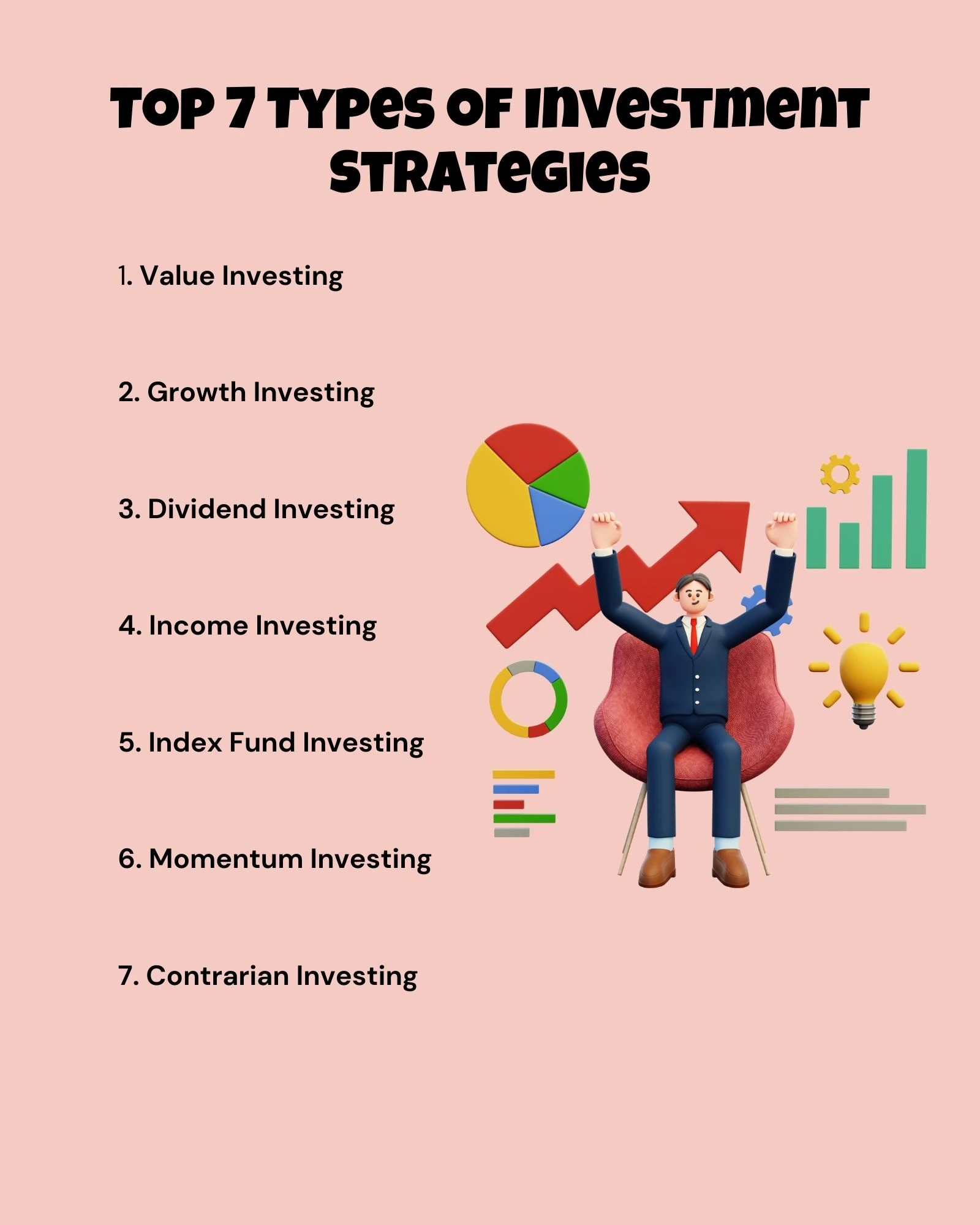- Table of Contents
- Introduction
- What's an Investment Strategy?
- What Constitutes an Investment Strategy?
- Investment Objectives
- Risk Profile
- Asset Allocation
- Investment Selection
- Investment Monitoring and Review
- Diversification
- Rebalancing
- How Is Having an Investment Strategy Helpful for Investors?
- Clear Financial Goals
- Risk Management
- Informed Decision-Making
- Discipline and Long-Term Focus
- Performance Evaluation
- Confidence and Peace of Mind
- Flexibility and Adaptability
- Top 7 Types of Investment Strategies
- 1. Value Investing
- 2. Growth Investing
- 3. Dividend Investing
- 4. Income Investing
- 5. Index Fund Investing
- 6. Momentum Investing
- 7. Contrarian Investing
- Which Strategy Is the Best One for Me?
- 1. Financial Goals
- 2. Risk Tolerance
- 3. Investment Knowledge
- 4. Time Commitment
- 5. Professional Guidance
- 6. Diversification
- The Role of Technology in Investment Strategies
- Sustainable Investing: A Growing Trend
- The Psychological Aspect of Investment Strategies
- Conclusion
Introduction
Investing is an essential aspect of building wealth and achieving financial success. However, diving into the world of investments without a well-defined strategy can be overwhelming and risky. That's where investment strategies come into play. An investment strategy is a carefully crafted plan outlining how to allocate your capital to maximise returns while minimising risks. In this comprehensive guide, we will explore the top seven types of investment strategies and help you understand which one might be the best fit for your financial goals.
What's an Investment Strategy?
Before delving into the various types of investment strategies, it's crucial to understand what an investment strategy is and how it functions. An investment strategy is a comprehensive plan encompassing your financial objectives, risk tolerance, time horizon, and desired returns. It serves as a roadmap for making informed decisions about where to invest your hard-earned money.
An investment strategy is not a static plan but a dynamic roadmap that evolves with your changing financial and market conditions. It provides you with a structured framework to adapt to new opportunities and challenges. As you progress along your financial journey, your investment strategy will serve as a guiding compass, helping you make informed decisions, manage risk, and stay focused on achieving your long-term financial goals. Whether you're aiming for wealth accumulation, financial security, or a comfortable retirement, a well-defined investment strategy is your trusted companion on the path to financial success.

What Constitutes an Investment Strategy?
To better understand investment strategies, let's explore the key components of a comprehensive investment strategy. While strategies can vary based on individual preferences and goals, there are common elements that form the foundation of an effective investment approach.
Investment Objectives
Investment objectives define what you aim to achieve with your investments. These objectives can include:
Capital Appreciation: Seeking to increase the value of your investments over time.
Income Generation: Focusing on generating steady income from your investments.
Wealth Preservation: Prioritising the protection of your existing wealth while seeking modest growth.
Clear and specific investment objectives provide a sense of purpose and guide your decision-making process.
Risk Profile
Your risk profile refers to your tolerance for volatility and potential loss. It is influenced by factors such as your financial situation, time horizon, and personal comfort level with market fluctuations. Understanding your risk profile is crucial as it helps determine the appropriate asset allocation and investment strategies that align with your risk appetite.
Asset Allocation
Asset allocation involves determining the distribution of your investment capital across different asset classes, such as:
Stocks: Equities represent ownership in companies and offer the potential for high returns but come with higher volatility.
Bonds: Fixed-income securities that provide regular interest payments and are considered less risky than stocks.
Real Estate: Investing in physical properties or real estate investment trusts (REITs) for diversification.
Cash: Holding cash or cash equivalents for liquidity and safety.
The allocation is based on your risk profile and investment goals. A well-diversified asset allocation can help manage risk and optimise returns by spreading investments across various sectors and markets.
Investment Selection
Once you have determined your asset allocation, the next step is selecting specific investments within each asset class. This involves:
- Conducting research
- Analysing investment options
- Considering factors such as historical performance, financial indicators, and market trends
Investment selection should be aligned with your investment objectives, risk tolerance, and time horizon.
Investment Monitoring and Review
Monitoring and reviewing your investments are essential components of an investment strategy. Regularly assessing your investments' performance helps ensure they align with your strategy and objectives. Monitoring also allows you to:
- Identify any necessary adjustments
- Explore rebalancing opportunities
- Stay informed about potential changes in market conditions that may require modifications to your strategy
Diversification
Diversification is a risk management technique that spreads investments across different assets, sectors, and geographic regions. It helps reduce the impact of individual investment losses on your overall portfolio and can enhance returns by capturing potential opportunities from different market segments. Diversification is a vital element of a robust investment strategy.
Rebalancing
Rebalancing is the process of realigning your investment portfolio to its original asset allocation targets. Over time, the performance of different investments within your portfolio may deviate, causing the allocation to shift. Rebalancing involves:
- Selling over-performing assets
- Purchasing underperforming assets
The goal is to return the portfolio to the desired asset allocation. Regular rebalancing ensures that your portfolio maintains its intended risk-return characteristics.
How Is Having an Investment Strategy Helpful for Investors?
Having a well-defined investment strategy offers numerous benefits for investors. Let's delve deeper into how an investment strategy can be helpful and impactful in your financial journey:
Clear Financial Goals
An investment strategy helps you set clear and realistic financial goals. By defining what you want to achieve, whether it's saving for retirement, purchasing a home, or funding your child's education, you can align your investment decisions with these objectives. A specific plan gives you direction and purpose, making it easier to stay focused on long-term goals rather than being swayed by short-term market fluctuations.
Risk Management
One of the fundamental aspects of investing is managing risk. An investment strategy provides a framework for managing risk effectively. By assessing your risk tolerance, you can determine how much volatility and potential loss you can withstand. Your strategy will guide you in diversifying your portfolio across different asset classes, such as stocks, bonds, and real estate, to spread risk. This diversification helps mitigate the impact of any single investment's poor performance on your overall portfolio.
Informed Decision-Making
An investment strategy encourages you to make informed decisions based on thorough research and analysis. It prompts you to study different investment options, evaluate their historical performance, analyse market trends, and consider relevant factors such as industry dynamics, competitive landscape, and financial ratios. This research-driven approach reduces the likelihood of making impulsive decisions driven by emotions or short-term market noise.
Discipline and Long-Term Focus
A well-crafted investment strategy helps you stay disciplined and maintain a long-term perspective. It provides a set of rules and guidelines to follow, preventing you from making rash decisions during market downturns or periods of euphoria. With a long-term focus, you can avoid the temptation of trying to time the market or chasing quick gains. Instead, you can stay invested and benefit from the power of compounding over time.
Performance Evaluation
An investment strategy allows you to evaluate the performance of your investments objectively. By comparing the returns generated by your portfolio against the benchmarks or goals you have set, you can assess the effectiveness of your strategy. This evaluation enables you to identify areas for improvement and make necessary adjustments to optimise your investment approach.
Confidence and Peace of Mind
Having a well-defined investment strategy instils confidence and peace of mind. It helps you navigate market volatility and economic uncertainties with a sense of control. Knowing that you have a carefully considered plan in place gives you the confidence to stick to your strategy during challenging times. This confidence helps you avoid succumbing to fear or panic, leading to better long-term investment outcomes.
Flexibility and Adaptability
While an investment strategy provides a roadmap, it allows flexibility and adaptability. The financial landscape and market conditions are constantly evolving, and your strategy should be able to accommodate changes. You can adjust your strategy as per your changing financial circumstances, risk tolerance, or investment opportunities. This flexibility ensures that your investment approach remains relevant and aligned with your long-term goals.
In short, an investment strategy is a valuable tool that empowers investors to make informed decisions, manage risk, and stay focused on their long-term financial goals. By setting clear objectives, evaluating risk, conducting thorough research, and maintaining discipline, investors can maximise their chances of achieving financial success. An investment strategy provides the framework and guidance necessary to navigate the complex investing world, allowing individuals to build wealth and secure their financial future.
Top 7 Types of Investment Strategies
Now that we understand the importance of investment strategies, let's explore the top seven types of investment strategies that investors commonly use:
1. Value Investing
Value investing is all about finding hidden gems in the stock market. Investors practising this strategy search for stocks that are trading below their intrinsic value. These undervalued stocks often have strong fundamentals, like healthy balance sheets and consistent cash flows. Value investors believe that the market will eventually recognise the true worth of these assets, leading to price appreciation. It's worth noting that value investing requires patience, as the market may take time to correct undervalued stocks.
2. Growth Investing
Growth investing focuses on companies with the potential for rapid earnings and revenue growth. These companies often operate in emerging industries or have disruptive technologies or innovative products. Investors attracted to growth strategies anticipate that the market will reward these firms with significant stock price increases as they expand. However, it's important to be aware that growth stocks can be more volatile, and they may not always live up to their growth expectations.
3. Dividend Investing
Dividend investing is a strategy that emphasises income generation. Investors in dividend stocks seek companies that regularly distribute a portion of their profits as dividends. This strategy especially appeals to those who desire a steady stream of passive income. Dividend investing offers a dual benefit—potential capital appreciation over time and dependable dividend payments. When selecting dividend stocks, consider a company's track record of consistent dividend payments and its ability to sustain them.
4. Income Investing
Income investing prioritises generating a consistent cash flow from investments, making it particularly suitable for retirees and those seeking regular income. This strategy often involves allocating capital to fixed-income securities like bonds, treasury bills, or high-yield dividend stocks. The focus is on stable returns rather than significant capital growth. Remember that income investments may carry varying degrees of risk, depending on the specific securities in your portfolio.
5. Index Fund Investing
Index fund investing offers a passive approach to the market. Instead of selecting individual stocks, investors opt for funds that track specific market indices, such as the S&P 500. This strategy provides broad market exposure and is known for its lower fees than actively managed funds. Index fund investors benefit from diversification and the potential for market returns, minus the need for continuous monitoring and stock-picking expertise.
6. Momentum Investing
Momentum investing revolves around the idea that assets that have performed well in the recent past will continue to do so. Investors employing this strategy closely analyse price trends and technical indicators. They believe that the market's momentum will persist, driving further price appreciation. Momentum investing can be highly rewarding during bullish markets but carries the risk of abrupt reversals during market corrections, making active monitoring crucial.
7. Contrarian Investing
Contrarian investors swim against the tide of market sentiment. They actively seek opportunities when the market is overly optimistic or pessimistic. Contrarian investing is rooted in the belief that market overreactions can create mispriced opportunities. Investors following this strategy often engage in thorough research and look for investments that may be undervalued or overvalued due to emotional market responses. Contrarian investing requires a strong conviction in your analysis and the ability to withstand periods when your view contradicts prevailing market sentiment.
In summary, each investment strategy has its unique characteristics and appeals to different types of investors. Consider your financial goals, risk tolerance, and investment horizon when choosing a strategy or combining elements of several strategies to create a personalised approach that aligns with your objectives. Remember that diversification across strategies can help spread risk and optimise your investment portfolio's potential for success.
Which Strategy Is the Best One for Me?
Determining the best investment strategy for your unique financial situation involves several factors and considerations. Here are some key points to help you make an informed decision:
1. Financial Goals
Short-Term vs. Long-Term: Consider whether your primary objective is short-term gains or long-term wealth accumulation. Different strategies align better with specific time horizons.
Specific Objectives: Define your financial goals clearly, whether it's saving for retirement, buying a home, funding education, or building an emergency fund. Your goals will dictate your strategy.
2. Risk Tolerance
Risk Capacity: Assess your financial capacity to withstand losses. Those with a higher risk capacity might be more comfortable with aggressive strategies, while others may prefer a conservative approach.
Emotional Comfort: Understand your psychological comfort with market volatility. If you're prone to anxiety during market downturns, a more conservative strategy might be preferable.
3. Investment Knowledge
Understanding and Expertise: Consider your level of understanding and expertise in financial markets. Some strategies may require a deeper understanding of individual stocks or complex financial instruments.
Learning Curve: Be open to learning and gaining knowledge about your chosen strategy. Investment strategies often require ongoing education and research.
4. Time Commitment
Active vs. Passive: Determine how actively you want to manage your investments. Some strategies, like index fund investing, require minimal effort, while others, like momentum investing, demand more frequent monitoring and adjustments.
5. Professional Guidance
Financial Advisor: Consider consulting a financial advisor. They can help assess your goals and risk tolerance and recommend suitable investment strategies tailored to your specific needs.
Asset Allocation: Professional guidance can be particularly valuable in optimising your asset allocation, which is a crucial aspect of any investment strategy.
6. Diversification
Spreading Risk: Understand the importance of diversification. Combining different investment strategies or asset classes can help spread risk and potentially enhance your overall portfolio performance.
Consideration | Details |
Financial Goals
| - Short-term vs. long-term objectives |
- Specific financial goals | |
Risk Tolerance
| - Risk capacity and comfort with volatility |
- Emotional response to market swings | |
Investment Knowledge
| - Understanding of financial markets |
- Willingness to learn and research | |
Time Commitment | - Active vs. passive investment |
Professional Guidance
| - Consulting a financial advisor |
- Asset allocation expertise | |
Diversification | - Spreading risk through diversification |
Table 1: Factors to consider when figuring out the best investment strategy
The Role of Technology in Investment Strategies
In recent years, technology has significantly shaped investment strategies. The availability of online brokerage platforms, robo-advisors, and financial apps has made it easier than ever for individuals to access and implement various investment strategies. These tools provide real-time data, automated portfolio management, and personalised investment recommendations, empowering investors to make more informed decisions.
Advantages of Technology in Investment Strategies |
|
|
|
|
|
Advantages of Technology in Investment Strategies |
|
|
|
|
|
Table 2: Advantages of Technology in Investment Strategies
Sustainable Investing: A Growing Trend
Sustainable investing, also known as ESG (Environmental, Social, and Governance) investing, is gaining popularity. This approach involves considering ethical and sustainability factors when making investment decisions. Investors prioritising sustainability may support companies with strong environmental practices, ethical labour standards, and transparent governance. Sustainable investing aligns financial goals with a commitment to social and environmental responsibility.
Points to Consider in Sustainable Investing:
- ESG Criteria: Evaluate investments based on ESG criteria, which include environmental impact, social responsibility, and corporate governance.
- Impact Investing: Consider investments that aim to generate both financial returns and positive social or environmental outcomes.
- Long-Term Perspective: Sustainable investing often aligns with a long-term investment horizon, focusing on companies with sustainable business practices.
The Psychological Aspect of Investment Strategies
Investing isn't just about numbers; it also involves understanding the psychological aspects that can impact decision-making. Emotions like fear and greed can lead to impulsive actions that may not align with your investment strategy. Understanding behavioural finance can help investors recognise and mitigate these emotional biases.
Key Psychological Factors in Investment Strategies:
- Loss Aversion: The tendency to fear losses more than we value gains can lead to selling investments during market downturns.
- Herd Mentality: Following the crowd can result in buying at market peaks and selling at lowes.
- Overconfidence: Believing in our ability to predict market movements can lead to excessive trading and portfolio turnover.
- Anchoring: Holding onto a specific price point as a reference can lead to reluctance in selling investments that are performing poorly.
Conclusion
Developing a well-defined investment strategy is crucial for achieving financial success. By understanding the various types of strategies and their benefits, you can make informed decisions aligned with your goals. Remember that investment strategies are adaptable, and you can adjust them over time as your financial situation and objectives evolve. Stay disciplined, leverage technology when appropriate, consider sustainable investing, and be mindful of the psychological factors that can influence your decisions. With a carefully crafted strategy and the right knowledge, you'll be on the path to building a prosperous financial future. And if you're looking to deepen your understanding of managing stocks and equity markets, be sure to check out our comprehensive course, ‘Managing Stocks & Equity Markets,’ to gain valuable insights and expertise in this dynamic field.

























